|
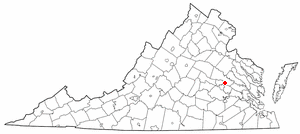
|
| Location of Mechanicsville |
Battle of Mechanicsville, Virginia
The Battle of Mechanicsville,
also known as the Battle of Beaver Dam Creek or Ellerson's Mill, took place on June 26, 1862, in Hanover County, Virginia,
as the first major engagement, but second battle, of the Seven Days Battles during the Peninsula Campaign of the American
Civil War. It was the start of Confederate General Robert E. Lee's counter-offensive against the Union Army of the Potomac,
under the command of Maj. Gen. George B. McClellan, which threatened the Confederate capital of Richmond. Lee attempted to turn the Union right flank, north of the Chickahominy
River, with troops under Maj. Gen. Thomas J. "Stonewall" Jackson, but Jackson failed to arrive on time. Instead, Maj. Gen. A.P. Hill threw his division, reinforced
by one of Maj. Gen. D.H. Hill's brigades, into a series of futile assaults against Brig. Gen. Fitz John Porter's V Corps,
which occupied defensive works behind Beaver Dam Creek. Confederate attacks were driven back with heavy casualties. Porter
withdrew his corps safely to Gaines Mill.
| Battle of Mechanicsville Virginia Map |
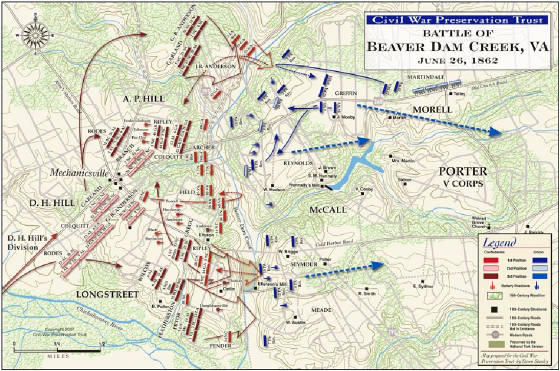
|
| (Click to Enlarge) |
| Seven Days Battles Map |
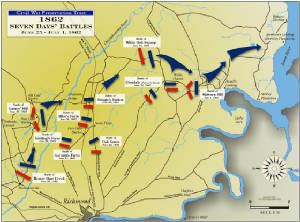
|
| (Click to Enlarge) |
Background
After the Battle of Seven
Pines, on May 31 and June 1, McClellan and the Army of the Potomac sat passively at the outskirts of Richmond
for almost a month. Lee, newly appointed commander of the Confederate Army of Northern Virginia, devoted this period to reorganizing
his army and preparing a counter-attack. He also sent for reinforcements. Stonewall Jackson arrived on June 25 from the Shenandoah Valley following his successful Valley Campaign. He brought four divisions: his own, now
commanded by Brig. Gen. Charles S. Winder, and those of Maj. Gen. Richard S. Ewell, Brig. Gen. William H. C. Whiting, and
Maj. Gen. D.H. Hill.
The Union Army straddled the rain-swollen Chickahominy River. Four of the Army's five
corps were arrayed in a semicircular line south of the river. The V Corps under Brig. Gen. Porter was north of the river near
Mechanicsville in an L-shaped line running north-south behind Beaver Dam Creek and southeast along the Chickahominy.
| Virginia Civil War Map of Battles |
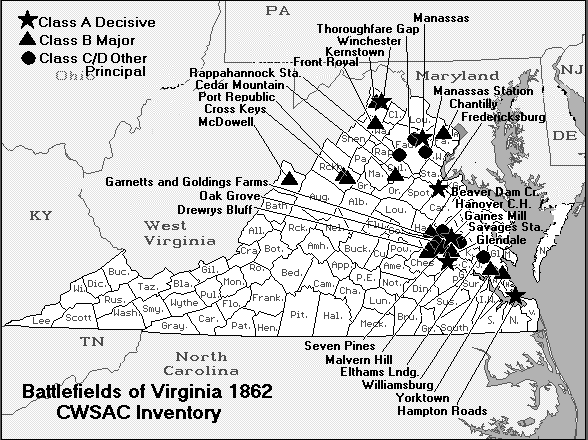
|
| (Click to Enlarge) |
Lee moved most of his army
north of the Chickahominy to attack the Union north flank. He left only two divisions (under Maj. Gens. Benjamin Huger and
John B. Magruder) to face the Union main body. This concentrated about 65,000 troops against 30,000, leaving only 25,000 to
protect Richmond
against the other 60,000 men of the Union army. It was a risky plan that required careful execution, but Lee knew that he
could not win in a battle of attrition or siege against the Union army. The Confederate cavalry under Brig. Gen. J.E.B. Stuart
had reconnoitered Porter's right flank and found it vulnerable. McClellan was aware of Jackson's
arrival and presence at Ashland Station, but did nothing to reinforce Porter's vulnerable corps north of the river.
Lee's plan
Lee's plan required
Jackson to begin the attack on Porter's north flank early
on June 26. Maj. Gen. A.P. Hill's Light Division was to advance from Meadow Bridge when he heard Jackson's guns,
clear the Union pickets from Mechanicsville, and then move to Beaver Dam Creek. The divisions of Maj. Gens. D.H. Hill and
James Longstreet were to pass through Mechanicsville, D.H. Hill to support Jackson, and Longstreet to support A.P. Hill. Lee
expected Jackson's flanking movement to force Porter to abandon
his line behind the creek, and so A. P. Hill and Longstreet would not have to attack Union entrenchments. South of the Chickahominy,
Magruder and Huger were to demonstrate, deceiving the four Union corps on their front.
| Battle of Mechanicsville |
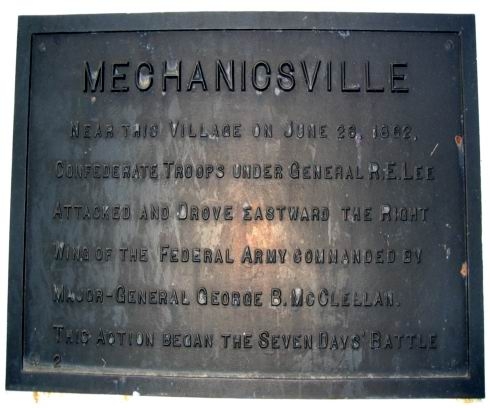
|
| Historical Marker |
| Battle of Beaver Dam Creek |
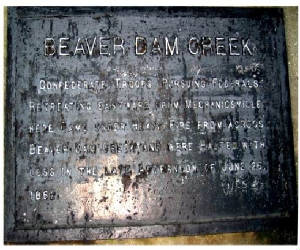
|
| (Click to Enlarge) |
Battle
Lee's intricate plan went
awry immediately. Jackson's men, fatigued from their recent
Valley Campaign and lengthy march, ran at least four hours behind schedule. By 3 p.m., A.P. Hill grew impatient and began
his attack without orders: a frontal assault with 11,000 men. Brig. Gen. George A. McCall's Union division was forced back.
Porter reinforced McCall with the brigades of Brig. Gens. John H. Martindale and Charles Griffin, and extended and strengthened
his right flank. He fell back and concentrated along Beaver Dam Creek and Ellerson's Mill. There, 14,000 well entrenched infantry,
supported by 32 guns in six batteries, repulsed repeated Confederate attacks with substantial casualties.
| Seven Days Battles |
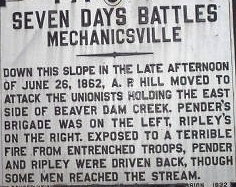
|
| Battle of Mechanicsville, VA |
Jackson
and his command arrived late in the afternoon. However, unable to locate A.P. Hill or D.H. Hill, Jackson was unable to support or engage. Although a major battle was raging within earshot,
he ordered his troops to bivouac for the evening. A.P. Hill, now with Longstreet and D.H. Hill behind him, continued his attack,
despite orders from Lee to hold his ground. His assault was beaten back with additional casualties.
Jackson did not attack, but his presence near Porter's flank caused McClellan to order Porter
to withdraw after dark behind Boatswain's Swamp, five miles to the east. McClellan was concerned that the Confederate buildup,
or reinforcement, on and against his right flank threatened his supply line, the Richmond and
York River Railroad north of the Chickahominy, and he decided to shift his base of supply to the James
River. (He also believed that the demonstrations by Huger and Magruder showed that he was seriously outnumbered.)
This was a strategic decision of grave import because it meant that, without the railroad to supply his army, he had to abandon
his siege of Richmond.
| Civil War Battle of Mechanicsville |
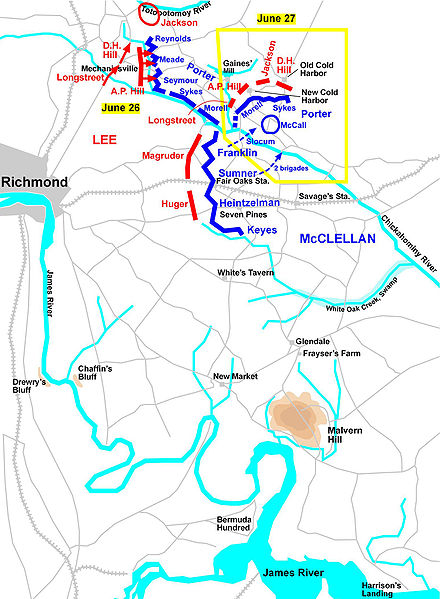
|
| Virginia 1862 Map |
| Beaver Dam Creek Battlefield |
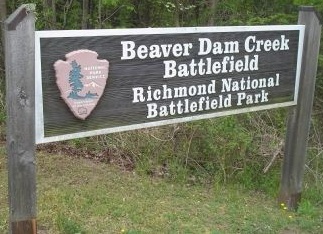
|
| Richmond National Battlefield Park |
Aftermath
Overall, the battle was
a Union tactical victory, in which the Confederates suffered heavy casualties and achieved none of their specific objectives
due to the seriously flawed execution of Lee's plan. Instead of more than 60,000 men crushing the enemy's flank, only five
brigades, about 15,000 men, had seen action. Their losses were 1,484 versus Porter's 361. Lee's staff recalled that he was
"deeply, bitterly disappointed" by Jackson's performance, but communication breakdowns, poorly written orders from Lee, and
bad judgment by most of Lee's other subordinates were also to blame.
Despite the Union tactical success,
however, it was the start of a strategic debacle and the unraveling of the Union Peninsula Campaign. McClellan began to withdraw
his army to the southeast and never regained the initiative. The next day the Seven
Days Battles continued as Lee attacked Porter at the Battle of Gaines' Mill.
A small portion of the battlefield
has been preserved as part of the Richmond National Battlefield Park, a park area administered by the National Park Service.
(Sources listed at bottom of page.)
Recommended Reading: To
The Gates of Richmond: The Peninsula Campaign,
by Stephen Sears. Description: To the Gates of Richmond charts the Peninsula Campaign of 1862, General George McClellan’s
grand scheme to march up the Virginia Peninsula
and take the Confederate capital. For three months, McClellan battled his way toward Richmond,
but then Robert E. Lee took command of the Confederate forces. In seven days, Lee drove the cautious McClellan out, thereby
changing the course of the war. Intelligent and well researched, To the Gates of Richmond vividly recounts one of the bloodiest
battles of the Civil War. Continued below…
Publishers Weekly: Sears complements
his 1988 biography of George McClellan with this definitive analysis of the general's principal campaign. McClellan's grand
plan was to land an army at Yorktown, move up the Virginia peninsula toward Richmond,
and fight a decisive battle somewhere near the Confederate capital, thereby ending the Civil War while it was still a rebellion
instead of a revolution. The strategy failed in part because of McClellan's persistent exaggerations of Confederate strength,
but also because under his command the Federals fought piecemeal. The Confederates were only marginally more successful at
concentrating their forces, but Sears credits their leaders, especially Lee, as better able to learn from experience. Confederate
victory on the Peninsula meant the Civil War would continue. The campaign's heavy casualties
indicated the kind of war it would be. About the Author: Stephen W. Sears is the author of six award-winning books on the
Civil War. He lives in Connecticut.
Recommended Reading:
The Richmond Campaign of 1862: The Peninsula and the Seven Days (Military
Campaigns of the Civil War) Description: The Richmond campaign of April-July 1862 ranks as one of the most important military
operations of the first years of the American Civil War. Key political, diplomatic, social, and military issues were at stake
as Robert E. Lee and George B. McClellan faced off on the peninsula between the York and James Rivers. The climactic clash
came on June 26-July 1 in what became known as the Seven Days battles, when Lee, newly appointed as commander of the Confederate
forces, aggressively attacked the Union army. Casualties for the entire campaign exceeded 50,000, more than 35,000 of whom
fell during the Seven Days. Continued below…
This book offers nine essays in
which well-known Civil War historians explore questions regarding high command, strategy and tactics, the effects of the fighting
upon politics and society both North and South, and the ways in which emancipation figured in the campaign. The authors have
consulted previously untapped manuscript sources and reinterpreted more familiar evidence, sometimes focusing closely on the
fighting around Richmond and sometimes looking more broadly at the background and consequences of the campaign.
From the Inside Flap: The Richmond campaign of April-July
1862 ranks as one of the most important military operations of the first years of the American Civil War. These nine original
essays, by well-known Civil War historians, explore questions regarding high command, strategy and tactics, the effects of
the fighting upon politics and society both North and South, and the ways in which emancipation figured in the campaign. Contributors:
William A. Blair, Keith S. Bohannon, Peter S. Carmichael, Gary
W. Gallagher, John T. Hubbell, R. E. L. Krick, Robert K. Krick, James Marten, and William J. Miller. About the Author: Gary
W. Gallagher is John L. Nau III Professor of History at the University
of Virginia. He has published widely on the Civil War, including six
previous titles in the Military Campaigns of the Civil War series.
Recommended Reading:
Extraordinary Circumstances: The Seven Days Battles. Description: Extraordinary
Circumstances tells the story of the Seven Days Battles, the first campaign in the Civil War in which Robert E. Lee led the
Army of Northern Virginia. One of the most decisive military campaigns in Western history, the Seven Days were fought in the
area southeast of the Confederate capitol of Richmond from June 25 to July 1, 1862--and began a string of events leading to
the Emancipation Proclamation and the shift toward total war. About the Author: Brian K. Burton is Associate Professor of
Management and Director of the MBA program at Western Washington University. Continued below...
Reviews:
"A full and measured account
marked by a clear narrative and an interesting strategy of alternating the testimony of generals with their grand plans and
the foot soldiers who had to move, shoot, and communicate in the smoky underbrush." -- The Virginia Magazine
"A thoroughly researched
and well-written volume that will surely be the starting point for those interested in this particular campaign." -- Journal
of American History
"A welcome addition to scholarship
that should be the standard work on its subject for some time to come." -- Journal of Military History
"A well-written, thoroughly researched
study of the Seven Days.... Provides thorough and reasonable analyses of the commanders on both sides." -- Georgia
Historical Quarterly
Recommended Reading: Seven
Days Before Richmond: McClellan's Peninsula Campaign Of 1862
And Its Aftermath (Hardcover). Description: Combining meticulous research with a unique perspective,
Seven Days Before Richmond examines the 1862 Peninsula Campaign of Union General George McClellan and the profound effects
it had on the lives of McClellan and Confederate General Robert E. Lee, as well as its lasting impact on the war itself. Rudolph
Schroeder’s twenty-five year military career and combat experience bring added depth to his analysis of the Peninsula
Campaign, offering new insight and revelation to the subject of Civil War battle history. Continued below…
Schroeder analyzes this crucial
campaign from its genesis to its lasting consequences on both sides. Featuring a detailed bibliography and a glossary of terms,
this work contains the most complete Order of Battle of the Peninsula Campaign ever compiled, and it also includes the identification
of commanders down to the regiment level. In addition, this groundbreaking volume includes several highly-detailed maps that
trace the Peninsula Campaign and recreate this pivotal moment in the Civil War. Impeccably detailed and masterfully told,
Seven Days Before Richmond is an essential addition to Civil War scholarship. Schroeder artfully enables us to glimpse the
innermost thoughts and motivations of the combatants and makes history truly come alive.
Recommended Reading: Sword
Over Richmond: An Eyewitness History Of McClellan's Peninsula
Campaign (Hardcover). Description: Publishers Weekly: Union General George McClellan's attempt to capture
the Confederate capital in 1862, one of the most significant campaigns of the Civil War, has been comparatively neglected
by popular historians, probably because of its complexity and seeming lack of coherent structure. Wheeler recounts it in a
way that should attract a large readership: the judicious use of extensive quotes by participants and observers, linked by
expositional passages of remarkable clarity, supported by good maps. Continued below…
The political and strategic aspects
of the campaign are given fair due, but the emphasis is on the human element. The central incidents on which the personal
narratives hang include the Monitor-Merrimack battle, "Stonewall" Jackson's diversionary maneuvers in the Shenandoah Valley
and Lee's daring counteroffensive in the Seven Days Battles. The book is rich in dramatic anecdote, telling detail and eloquence.
Recommended Reading: The
Official Virginia Civil War Battlefield Guide.
Review: This is one of the most useful guides I've ever read. Virginia
was host to nearly 1/3rd of all Civil War engagements, and this guide covers them all like a mini-history of the war. Unlike
travel books that are organized geographically, this guide organizes them chronologically. Each campaign is prefaced by a
detailed overview, followed by concise (from 1 to 4 pages, depending on the battle's importance) but engrossing descriptions
of the individual engagements. These descriptions make this a great book to browse through when you're not in the car. Most
sites' summaries touch on their condition--whether they're threatened by development (as too many are) and whether they're
in private hands or protected by the park service. Continued below…
But the maps are where this book
really stands out. Each battle features a very clear map designating army positions and historical roads, as well as historical
markers (the author also wrote the /A Guidebook to Virginia's Historical Markers/), parking, and visitors'
centers. Best of all, though, many battles are illustrated with paintings or photographs of the sites, and the point-of-view
of these pictures is marked on each map!
Sources: Eicher, John H., and
Eicher, David J., Civil War High Commands, Stanford University Press, 2001, ISBN 0-8047-3641-3; Esposito, Vincent J., West
Point Atlas of American Wars, Frederick A. Praeger, 1959; Kennedy, Frances H., Ed., The Civil War Battlefield Guide, 2nd ed.,
Houghton Mifflin Co., 1998, ISBN 0-395-74012-6; Salmon, John S., The Official Virginia Civil War Battlefield Guide, Stackpole
Books, 2001, ISBN 0-8117-2868-4; Sears, Stephen W., To the Gates of Richmond: The Peninsula Campaign, Ticknor and Fields,
1992, ISBN 0-89919-790-6; National Park Service; Library of Congress; Richmond National Battlefield Park; Civil War Preservation
Trust.
|

